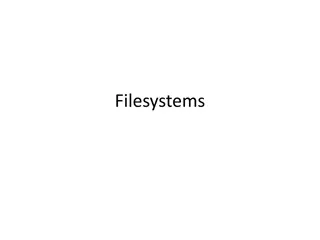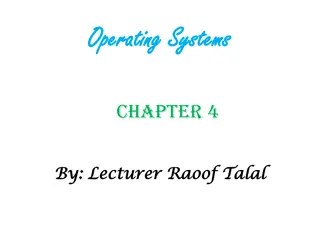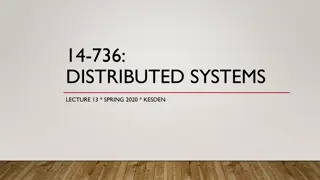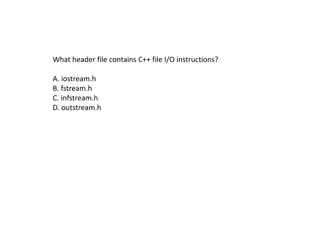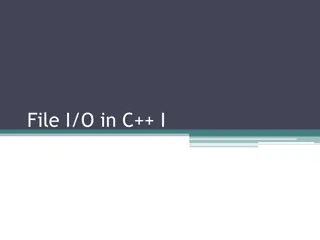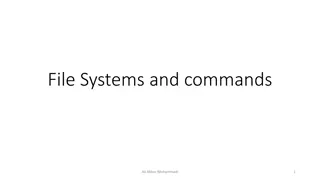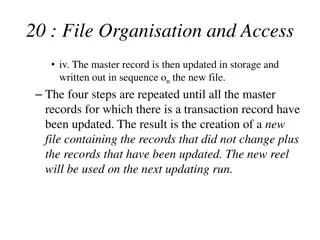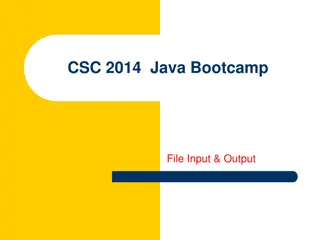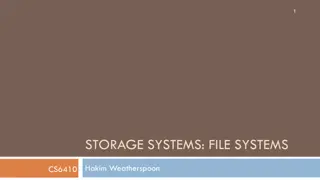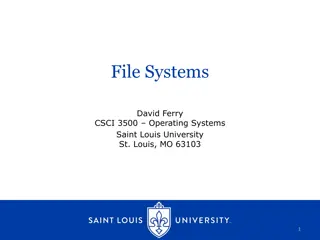
Understand File I/O in Python: Best Practices and Examples
Learn about file input/output in Python, focusing on opening, reading, and writing files. Explore concepts like escape sequences, using the split() and join() functions, and different ways to interact with files. Get practical examples and tips for efficient file handling in Python programming.
Download Presentation

Please find below an Image/Link to download the presentation.
The content on the website is provided AS IS for your information and personal use only. It may not be sold, licensed, or shared on other websites without obtaining consent from the author. If you encounter any issues during the download, it is possible that the publisher has removed the file from their server.
You are allowed to download the files provided on this website for personal or commercial use, subject to the condition that they are used lawfully. All files are the property of their respective owners.
The content on the website is provided AS IS for your information and personal use only. It may not be sold, licensed, or shared on other websites without obtaining consent from the author.
E N D
Presentation Transcript
CMSC201 Computer Science I for Majors Lecture 11 File I/O (Continued) Prof. Katherine Gibson www.umbc.edu Based on concepts from: http://mcsp.wartburg.edu/zelle/python/ppics2/code/
Last Class We Covered Escape sequences Uses a backslash (\) File I/O Input/Output How to open a file For reading or writing How to read lines from a file 2 www.umbc.edu
Any Questions from Last Time? www.umbc.edu
Todays Objectives To review how to open and read from a file To learn how to use the split() function To break a string into tokens And to learn the join() function To get more practice with File I/O To cover the different ways to write to a file To learn how to close a file 4 www.umbc.edu
Review from Last Class www.umbc.edu
Using open() Which of these are valid uses of open()? 1.myFile = open(12, "r") 2.fileObj = open("HELLO.txt") 3.writeTo = open(fileName, "w") 4."file" = open("test.dat", "R") 5.theFile = open("file.dat", "a") 6 www.umbc.edu
Using open() Which of these are valid uses of open()? not a valid filename not a valid string 1.myFile = open(12, "r") 2.fileObj = open("HELLO.txt") 3.writeTo = open(fileName, "w") 4."file" = open("test.dat", "R") 5.theFile = open("file.dat", "a") uppercase R is not a valid access mode 7 www.umbc.edu
Three Ways to Read a File Write the code that will perform each of these actions using a file object called aFile 1. Read the whole file in as one big long string 2. Read the first line of the file 3. Read the file in as a list of strings (each is one line) 8 www.umbc.edu
Three Ways to Read a File Write the code that will perform each of these actions using a file object called aFile 1. Read the whole file in as one big long string bigString = aFile.read() 2. Read the first line of the file firstLine = aFile.readline() 3. Read the file in as a list of strings (each is one line) stringList = aFile.readlines() 9 www.umbc.edu
Whitespace There are two ways we know of to remove whitespace from a string Slicing can be used to remove just the newline at the end of a line that we have read in from a file: myLineWithoutNewline = myLine[:-1] The strip() function removes all leading and trailing whitespace (tabs, spaces, newlines) from a string withoutWhitespace = myLine.strip() 10 www.umbc.edu
Using for Loops to Read in Files Remember, for loops are great for iterating! With a list, the forloop iterates over Each element of the list (in order) Using a range(), the forloop iterates over Each number generated by the range (in order) And with a file, the forloop iterates over Each line of the file (in order) 11 www.umbc.edu
String Splitting www.umbc.edu
String Splitting We can break a string into individual pieces That you can then loop over! The function is called split(), and it has two ways it can be used: Break the string up by its whitespace Break the string up by a specific character 13 www.umbc.edu
Splitting by Whitespace Calling split() with no arguments will remove all of the whitespace in a string Even the inside whitespace >>> line = "hello world this is my song\n" >>> line.split() ['hello', 'world', 'this', 'is', 'my', 'song'] >>> whiteCat = "\t\nI love\t\t\nwhitespace\n " >>> whiteCat.split() ['I', 'love', 'whitespace'] 14 www.umbc.edu
Splitting by Specific Character Calling split() with a string in it, we can remove a specific character (or more than one) these character(s) are called the delimiter >>> commas = "once,twice,thrice" >>> commas.split(",") ['once', 'twice', 'thrice'] >>> double = "hello how ill are all of your llamas?" >>> double.split("ll") ['he', 'o how i', ' are a', ' of your ', 'amas?'] 15 www.umbc.edu
Splitting by Specific Character Calling split() with a string in it, we can remove a specific character (or more than one) these character(s) are called the delimiter >>> commas = "once,twice,thrice" >>> commas.split(",") ['once', 'twice', 'thrice'] >>> double = "hello how ill are all of your llamas?" >>> double.split("ll") ['he', 'o how i', ' are a', ' of your ', 'amas?'] notice that it didn t remove the whitespace 16 www.umbc.edu
Practice: Splitting Use split() to solve the following problems Split this string on all of its whitespace: daft = "around the \nworld" Split this string on the double t s (tt): doubleT = "nutty otters making lattes" 17 www.umbc.edu
Practice: Splitting Use split() to solve the following problems Split this string on all of its whitespace: daft = "around the \nworld" daft.split() Split this string on the double t s (tt): doubleT = "nutty otters making lattes" doubleT.split("tt") 18 www.umbc.edu
Looping over Split Strings Splitting a string creates a list of smaller strings Using a for loop with a split string, we can iterate over each word (or token) in the string Syntax: for piece in myString.split(): # do something with each piece 19 www.umbc.edu
Example: Looping over Split Strings >>> double = "hello how ill are all of your llamas? >>> for token in double.split("ll"): ... print("y" + token + "y") ... yhey yo how iy y are ay y of your y yamas?y remember, double.split("ll") makes the list ['he', 'o how i', ' are a', ' of your ', 'amas?'] append a y to the front and end of each list element, then print 20 www.umbc.edu
String Joining www.umbc.edu
Joining Strings We can also join a list of strings back together! The syntax is very different from split() And it only works on a list of strings "X".join(LIST_OF_STRINGS) function name the list of strings we want to join together the delimiter (what we will use to join the strings) 22 www.umbc.edu
Example: Joining Strings >>> names = ['Alice', 'Bob', 'Candi', 'Dave', 'Eve'] >>> "_".join(names) 'Alice_Bob_Candi_Dave_Eve' We can also use more than one character as our delimiter if we want >>> " <3 ".join(names) 'Alice <3 Bob <3 Candi <3 Dave <3 Eve' 23 www.umbc.edu
Splitting into Variables www.umbc.edu
Known (Formatted) Input Known input means that we know how the data inside a file will be formatted (laid out) For example, in workerHours.txt, we have: The employee ID number The employee s name The hours worked over five days workerHours.txt 123 Suzy 9.5 8.1 7.6 3.1 3.2 456 Brad 7.0 9.6 6.5 4.9 8.8 789 Jenn 8.0 8.0 8.0 8.0 7.5 25 www.umbc.edu https://courses.cs.washington.edu/courses/cse142/11au/python/06-files.ppt
Splitting into Variables If we know what the input will look like, we can split() them directly into different variables var1, var2, var3 = threePartString.split() all of the variables we want to split the string into the string whose input we know, and are splitting on we can have as many different variables as we want 26 www.umbc.edu https://courses.cs.washington.edu/courses/cse142/11au/python/06-files.ppt
Example: Splitting into Variables >>> s = "Jessica 31 647.28" >>> name, age, money = s.split() >>> name 'Jessica' >>> int(age) 31 >>> float(money) 647.28 we may want to convert some of them to something that s not a string https://courses.cs.washington.edu/courses/cse142/11au/python/06-files.ppt 27 www.umbc.edu
Writing to Files www.umbc.edu
Opening a File for Writing Use open() just like we do for reading Provide the filename and the access mode fileObj = open("output.txt", "w") Opens the file for writing Wipes the contents! fileObj = open("myNotes.txt", "a") Opens the file for appending Writes new data to the end of the file 29 www.umbc.edu
Writing to a File Once a file has been opened, we can write to it myFile.write( "hello world!" ) We can also use a string variable in write() myFile.write( writeString ) 30 www.umbc.edu
Word of Caution Write can only take one string at a time! Why don t these work? the first is multiple strings the second is an int, not a string These won t work: fileObj.write("hello", "my", "name") fileObj.write(17) Why does this work? concatenation creates one string But this will: fileObj.write("hello" + " my " + "name") 31 www.umbc.edu
Closing a File Once we are done with our file, we close it We do this for all files ones that we opened for writing, reading, and appending! myFileObject.close() Properly closing the file is important why? It ensures that the file is saved correctly 32 www.umbc.edu
Exercise: Writing to a File Remember our grocery list program? At the end of our program, the user has added all of their items to the list grocery_list Write the contents of grocery_list to a file Don t forget to open and close the file! 33 www.umbc.edu
Solution: Writing to a File # code above this populates grocery_list # open file for writing gFile = open("groceries.txt", "w") for g in grocery_list: # print each item, plus a newline gFile.write(g + "\n") # close file gFile.close() 34 www.umbc.edu
Writing to a File: Newlines Why did we need a newline in our example? Without it, our file looks like this: durianscoconutlimecoke But with it, each item is on a separate line: durians coconut lime coke 35 www.umbc.edu
Batch Programs www.umbc.edu
Batch Programs Batch mode processing is where program input and output are done entirely with files The program is not designed to be interactive 37 www.umbc.edu
Practice www.umbc.edu
Exercise Suppose we have this hours.txt data: 123 Suzy 9.5 8.1 7.6 3.1 3.2 456 Brad 7.0 9.6 6.5 4.9 8.8 789 Jenn 8.0 8.0 8.0 8.0 7.5 Compute each worker's total hours and hours/day Assume each worker works exactly five days Sample output: workerHours.txt 123 Suzy 9.5 8.1 7.6 3.1 3.2 456 Brad 7.0 9.6 6.5 4.9 8.8 789 Jenn 8.0 8.0 8.0 8.0 7.5 Suzy ID 123 worked 31.4 hours: 6.3 / day Brad ID 456 worked 36.8 hours: 7.36 / day Jenn ID 789 worked 39.5 hours: 7.9 / day www.umbc.edu From: https://courses.cs.washington.edu/courses/cse142/11au/python/06-files.ppt
Exercise Answer def main(): input = open("hours.txt") for line in input: id, name, mon, tue, wed, thu, fri = line.split() # cumulative sum of this employee's hours hours = float(mon) + float(tue) + float(wed) + \ float(thu) + float(fri) print(name, "ID", id, "worked", \ hours, "hours: ", hours/5, "/ day") main() www.umbc.edu From: https://courses.cs.washington.edu/courses/cse142/11au/python/06-files.ppt
Exercise Write code to read a file of gas prices in USA and Belgium: 8.20 3.81 3/21/11 8.08 3.84 3/28/11 8.38 3.92 4/4/11 ... Output the average gas price for each country to an output file named gasout.txt www.umbc.edu From: https://courses.cs.washington.edu/courses/cse142/11au/python/06-files.ppt
Exercise: Batch Usernames Let s create usernames for a computer system where the first and last names come from an input file A username is the first letter of their first name, and the first 7 letters of their last name (lowercase) Get the input and output files from the user 42 www.umbc.edu
Example Program: Batch Usernames # userfile.py # Program to create a file of usernames in batch mode. def main(): print ("This program creates a file of usernames from a") print ("file of names.") # get the file names infileName = input("What file are the names in? ") outfileName = input("What file should the usernames go in? ") # open the files infile = open(infileName, 'r') outfile = open(outfileName, 'w') [continued...] www.umbc.edu
Example Program: Batch Usernames [...continued] # process each line of the input file for line in infile: # get the first and last names from line first, last = line.split() # create a username uname = (first[0]+last[:7]).lower() # write it to the output file print(uname, file=outfile) # close both files infile.close() outfile.close() print("Usernames have been written to", outfileName) www.umbc.edu
Announcements We will be doing an in-class worksheet next time Bring pencils and paper (or your notebook) Homework 4 is out Due by Tuesday (Oct 6th) at 8:59:59 PM Midterm is next week Oct 14th and 15th You must bring your UMBC ID with you to the exam! We won t accept your test without it. 45 www.umbc.edu



